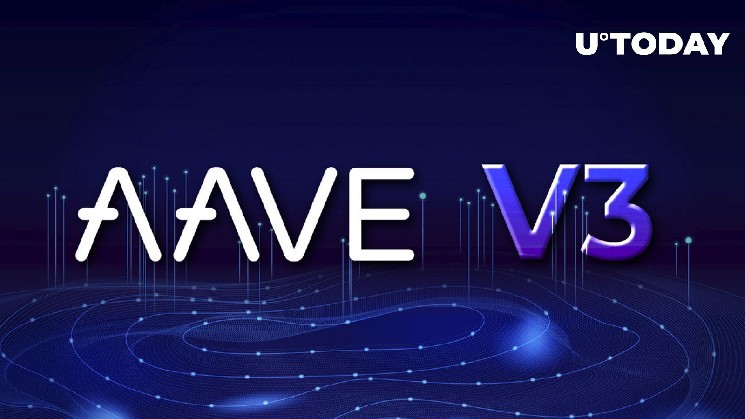Aave V3 Explained: Everything You Need to Know

The Aave team recently announced the launch of the latest iteration of their decentralized lending protocol, version 3, on the Ethereum network. This update is considered the most substantial improvement to the DeFi platform to date. It is important to note that while the integration of Ethereum is newsworthy, V3 has already been available on other high-performance networks such as Polygon, Avalanche and Arbitrum since 2022.
Before delving into the details of the update, it is crucial to understand the preceding versions of the protocol. Aave traces its origins to ETHLend, established in 2017, which underwent a rebranding to become Aave in 2018. The platform was created to address the scarcity of decentralized lending options on the Ethereum network, according to founder Stani Kulechov.
Aave v1 enabled users to engage in lending and borrowing activities with a limited range of digital assets, including ETH and ERC-20 tokens. However, it was limited in terms of security features and governance options.
Aave v2, released in 2020, marked a significant advancement in functionality, security and governance. The update introduced support for additional digital assets and empowered users to play a more active role in shaping the direction of the decentralized finance protocol through improved governance mechanisms.
Get to know Aave V3
Aave V3 aims to enhance the appeal of the platform through the introduction of new features and optimizations. These include the addition of risk management tools, increased capital efficiency and improved decentralized liquidity, resulting in a 25% reduction in gas fees.
Lower rates and improved functionality are key factors in attracting more users to the platform. The cost reduction is coupled with code optimizations that make it clearer and more efficient, including a simplified flashloan function for low-cost loan options.
Flash loan is a feature that allows users to take out an unsecured loan for a brief period and repay the funds in the same Ethereum block before incurring any interest charges. This feature offers users greater flexibility and efficiency in executing complex financial transactions.
V3 has also brought changes to eMode, which provides higher leverage rates in Aave for more efficient lending when collateral and loaned assets exhibit similar volatility. With the new version, the leverage ratio has increased from 82.5% to as high as 97% based on the correlation of assets. It is important to note that eMode will only support Ethereum-based assets.
Open Zeppelin and PeckShield are among the companies that audited Aave V3.
Aave growth
This release could be very important for the decentralized protocol. Although Aave has one of the highest TVL on Ethereum’s network, the platform still has the problem of user retention. In addition, V3 can strengthen lending networks in DeFi that are losing market space to DEXes.
Decentralized exchanges dominate the decentralized financial scene, making up 33% of TVL. Lending protocols, meanwhile, represent a 20% share. To keep up the pace of growth, Aave has been investing in upgrades and partnerships, aiming to break out of the over-leveraged trend of 2022.






 Bitcoin
Bitcoin  Ethereum
Ethereum  Tether
Tether  USDC
USDC  TRON
TRON  Dogecoin
Dogecoin  Cardano
Cardano  Bitcoin Cash
Bitcoin Cash  Chainlink
Chainlink  Monero
Monero  LEO Token
LEO Token  Zcash
Zcash  Stellar
Stellar  Litecoin
Litecoin  Hedera
Hedera  Dai
Dai  Cronos
Cronos  OKB
OKB  Tether Gold
Tether Gold  Ethereum Classic
Ethereum Classic  KuCoin
KuCoin  Algorand
Algorand  Gate
Gate  Cosmos Hub
Cosmos Hub  VeChain
VeChain  Stacks
Stacks  Tezos
Tezos  Dash
Dash  TrueUSD
TrueUSD  IOTA
IOTA  Basic Attention
Basic Attention  Theta Network
Theta Network  Decred
Decred  NEO
NEO  Synthetix
Synthetix  Qtum
Qtum  Ravencoin
Ravencoin  0x Protocol
0x Protocol  DigiByte
DigiByte  Zilliqa
Zilliqa  Holo
Holo  Nano
Nano  Siacoin
Siacoin  Numeraire
Numeraire  Waves
Waves  Status
Status  Enjin Coin
Enjin Coin  Ontology
Ontology  Hive
Hive  BUSD
BUSD  Lisk
Lisk  Pax Dollar
Pax Dollar  Steem
Steem  Huobi
Huobi  NEM
NEM  OMG Network
OMG Network  Bitcoin Gold
Bitcoin Gold  Augur
Augur